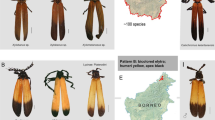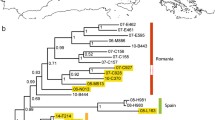Abstract
Polymorphism in aposematic animals and coexistence of multiple mimicry rings within a habitat are not predicted by classical Müllerian mimicry. The butterfly Heliconius numata Cramer (Lepidoptera: Nymphalidae; Heliconiinae) is both polymorphic and aposematic. The polymorphism is due to variation at a single locus (or `supergene') which determines colour patterns involved in Müllerian mimicry. We sampled 11 sites in a small area (approx. 60×30km) of North-eastern Peru for H. numata and its co-mimics in the genus Melinaea and Athyrtis (Ithomiinae), and examined the role of temporal and spatial heterogeneity in the maintenance of polymorphism. Colour-patterns of Melinaea communities, which constitute the likely `mimetic environment' for H. numata, are differentiated on a more local scale than morphs of H. numata, but the latter do show a strong and significant response to local selection for colour-pattern. In contrast, analysis of enzyme polymorphism in H. numata across the region revealed no spatial structure, which is consistent with a high mobility of this species. Differences in spatial variability in the two taxa may have caused H. numata to become polymorphic, while temporal variability, not significant in this study, probably has a lesser effect. The mimetic polymorphism is therefore explained by means of multiple selection-migration clines at a single locus, a similar process to that which explains narrow hybrid zones between geographic races of other Heliconius butterflies.
Similar content being viewed by others

References
Aitkin, M., Anderson, D., Francis, B. and Hinde, J. (1989) Statistical Modelling in GLIM. Oxford University Press, Oxford, UK.
Bates, H.W. (1862) Contributions to an insect fauna of the Amazon valley. Lepidoptera: Heliconidae. Trans. Linn. Soc. Lond. 23, 495-566.
Beccaloni, G.W. (1997a) Ecology, natural history and behaviour of ithomiine butterflies and their mimics in Ecuador (Lepidoptera: Nymphalidae: Ithomiinae). Trop. Lepid. 8, 103-124.
Beccaloni, G.W. (1997b) Vertical stratification of ithomiine butterfly (Nymphalidae: Ithomiinae) mimicry complexes: the relationship between adult flight height and larval host-plant height. Biol. J. Linn. Soc. 62, 313-341.
Brown, K.S. (1976) An illustrated key to the silvaniform Heliconius (Lepidoptera: Nymphalidae) with descriptions of new subspecies. Trans. Am. Entom. Soc. 102, 373-484.
Brown, K.S. (1977) Geographical patterns of evolution in Neotropical Lepidoptera: differentiation of the species of Melinaea and Mechanitis (Nymphalidae, Ithomiinae). Syst. Entomol. 2, 161-197.
Brown, K.S. (1979) Ecologia Geográfica e Evolução nas Florestas Neotropicais. Universidade Estadual de Campinas, Campinas, Brazil.
Brown, K.S. (1987) Chemistry at the Ithomiinae-Solanaceae interface. Ann. Miss. Bot. Gard. 74, 359-397.
Brown K.S. and Benson, W.W. (1974) Adaptive polymorphism associated with multiple Müllerian mimicry in Heliconius numata. Biotropica 6, 205-228.
Chai, P. (1996) Butterfly visual characteristics and ontogeny of responses to butterflies by a specialized tropical bird. Biol. J. Linn. Soc. 59, 37-67.
Clarke, C.A., Clarke, F.M.M. and Gordon, I.J. (1995) Mimicry and other controversial topics in East African Lepidoptera. J. East Afr. Nat. Hist. 84, 3-18.
Cook, L.M. and Brower, L.P. (1969) Observations of polymorphism in two species of heliconiine butterflies from Trinidad, West Indies. Entomologist 102, 125-128.
Dempster, E.R. (1955) Maintenance of genetic heterogeneity. Cold Spring Harb. Symp. Quant. Biol. 70, 25-32.
Huheey, J.E. (1976) Studies of warning coloration and mimicry. VII. Evolutionary consequences of a Batesian-Müllerian spectrum: a model for Müllerian mimicry. Evolution 30, 86-93.
Jiggins, C.D., McMillan, W.O., King, P. and Mallet, J. (1997) The maintenance of species differences across a Heliconius hybrid zone. Heredity 79, 495-505.
Joron, M. (2000) Warning colour and Müllerian mimicry: the diversification puzzle. Doctoral Thesis, Département Biologie, Evolution, Environnement, Université de Montpellier II, Montpellier, France, pp. 225.
Joron, M. and Mallet, J. (1998) Diversity in mimicry: paradox or paradigm? Trends Ecol. Evol. 13, 461-466.
Kapan, D. (2001) Three-butterfly system provides first field test of Müllerian mimicry. Nature 409, 338-340.
Lamas, G. (1982) A preliminary zoogeographical division of Peru, based on butterfly distributions (Lepidoptera, Papilionoidea). In G.T. Prance (ed.) Biological Diversification in the Tropics. Columbia University Press, New York, USA, pp. 336-357.
Linares, M. (1997) Origin of neotropical mimetic diversity from a three-way hybrid zone of Heliconius cydno butterflies. In H. Ulrich (ed.) Tropical Diversity and Systematics. Proceedings of the International Symposium on Biodiversity and Systematics in Tropical Ecosystems, Bonn, 1994. Zoologisches Forschunginstitut und Museum Alexander Koenig, Bonn, Germany, pp. 93-108.
Mallet, J. (1986a) Dispersal and gene flow in a butterfly with home range behaviour: Heliconius erato (Lepidoptera: Nymphalidae). Oecologia 68, 210-217.
Mallet, J. (1986b) Gregarious roosting and home range in Heliconius butterflies. Natl. Geogr. Res. 2, 198-215.
Mallet, J. (1989) The genetics of warning colour in Peruvian hybrid zones of Heliconius erato and H. melpomene. Proc. R. Soc. London B Biol. Sci. 236, 163-185.
Mallet, J. (2001) Causes and consequences of a lack of coevolution in Müllerian mimicry. Evol. Ecol. 13, 777-806.
Mallet, J. and Barton, N.H. (1989) Strong natural selection in a warning colour hybrid zone. Evolution 43, 421-431.
Mallet, J., Barton, N.H., Lamas, G., Santisteban C.J., Muedas M.M. and Eeley, H. (1990) Estimates of selection and gene flow from measures of cline width and linkage disequilibrium in Heliconius hybrid zones. Genetics 124, 921-936.
Mallet, J. and Gilbert, L.E. (1995) Why are there so many mimicry rings? Correlations between habitat, behaviour and mimicry in Heliconius butterflies. Biol. J. Linn. Soc. 55, 159-180.
Mallet, J. and Joron, M. (1999) Evolution of diversity in warning color and mimicry: polymorphisms, shifting balance and speciation. Annu. Rev. Ecol. Syst. 30, 201-233.
Mallet, J., Korman, A., Heckel, D.G. and King, P. (1993) Biochemical genetics of Heliothis and Helicoverpa (Lepidoptera: Noctuidae) and evidence for a founder event in Helicoverpa zea. Ann. Entom. Soc. Am. 86, 189-197.
Mallet, J., Longino, J.T., Murawski, D., Murawski, A. and Simpson de Gamboa, A. (1987) Handling effect in Heliconius: where do all the butterflies go? J. Anim. Ecol. 56, 377-386.
Mallet, J., McMillan, W.O. and Jiggins, C.D. (1998) Mimicry and warning color at the boundary between races and species. In D. Howard and S. Berlöcher (eds) Endless Forms: Species and Speciation. Oxford University Press, New York, USA, pp. 390-403.
Muko S. and Iwasa, Y. (2000) Species coexistence by permanent spatial heterogeneity in a lottery model. Theor. Popul. Biol. 57, 273-284.
Müller, F. (1879) Ithuna and Thyridia: a remarkable case of mimicry in butterflies. Trans. Entomol. Soc. Lond. 1879, xx-xxix.
Owen, D.F., Smith, D.A.S., Gordon, I.J. and Owiny, A.M. (1994) Polymorphic Müllerian mimicry in a group of African butterflies: a re-assessment of the relationship between Danaus chrysippus, Acraea encedon and Acraea encedana (Lepidoptera: Nymphalidae). J. Zool. 232, 93-108.
Owen, R.E. and Owen, A.R.G. (1984) Mathematical paradigms for mimicry: recurrent sampling. J. Theor. Biol. 109, 217-247.
Raymond, M. and Rousset, F. (1995) GENEPOP (version 1.2): population genetics software for exact tests and ecumenism. J. Hered. 86, 248-249.
Raymond, M. and Rousset, F. (2000) GENEPOP 3.2. Updated version: ftp://ftp.cefe.cnrs-mop.fr/genepop/(March 2000).
Richardson, B.J. Baverstock, P.R. and Adams, M. (1986) Allozyme Electrophoresis. A Handbook for Animal Systematics and Population Studies. Academic Press, San Diego, USA.
Roughgarden, J. (1979) Theory of Population Genetics and Evolutionary Ecology: an introduction. MacMillan Publishers, New York, USA.
Smith, D.A.S., Owen, D.F., Gordon, I.J. and Owiny, A.M. (1993) Polymorphism and evolution in the butterfly Danaus chrysippus L. (Lepidoptera: Danainae). Heredity 71, 242-251.
Smith, D.A.S., Gordon, I.J., Depew, L.A. and Owen, D.F. (1998) Genetics of the butterfly Danaus chrysippus (L.) in a broad hybrid zone, with special reference to sex ratio, polymorphism and intragenomic conflict. Biol. J. Linn. Soc. 65, 1-40.
Smith, D.A.S., Owen, D.F., Gordon, I.J. and Lowis, N.K. (1997) The butterfly Danaus chrysippus (L.) in East Africa: polymorphism and morph-ratio clines within a complex, extensive and dynamic hybrid zone. Zool. J. Linn. Soc. 120, 51-78.
Sokal, R.R. and Rohlf, F.J. (1995) Biometry. The Principles and Practice of Statistics in Biological Research. W.H. Freeman & Co., New York, USA.
Speed, M.P. (1993) Müllerian mimicry and the psychology of predation. Anim. Behav. 45, 571-580.
Speed, M.P. and Turner, J.R.G. (1999) Learning and memory in mimicry: II. Do we understand the mimicry spectrum?. Biol. J. Linn. Soc. 67, 281-312.
Speed, M.P. (2001) Batesian, quasi-Batesian or Müllerian mimicry? Theory and data in mimicry research. Evol. Ecol. 13, 755-776.
Srygley, R.B. and Chai, P. (1990) Predation and the elevation of thoracic temperature in brightly colored Neotropical butterflies. Am. Nat. 135, 766-787.
Turner, J.R.G. (1995) Mimicry as a model for coevolution. In R. Arai, M. Kato and Y. Doi (eds) Biodiversity and Evolution. The National Science Museum Foundation, Tokyo, Japan, pp. 131-150.
Turner, J.R.G., Kearney, E.P. and Exton, L.S. (1984) Mimicry and the Monte Carlo predator: the palatability spectrum and the origins of mimicry. Biol. J. Linn. Soc. 23, 247-268.
Wynne, I.R., Loxdale, H.D. and Brookes, C.P. (1992) Use of cellulose acetate system for allozyme electrophoresis. In R.J. Berry, T.J. Crawford and G.M. Hewitt (eds) Genes in Ecology. Blackwell, Oxford, UK, pp. 494-499.
Wynne, I.R., and Brookes, C.P. (1992) A device for producing multiple deep-frozen samples for allozyme electrophoresis. In R.J. Berry, T.J. Crawford and G. M. Hewitt (eds) Genes in Ecology. Blackwell, Oxford, UK, pp. 500-502.
Author information
Authors and Affiliations
Corresponding author
Rights and permissions
About this article
Cite this article
Joron, M., Wynne, I.R., Lamas, G. et al. Variable Selection and the Coexistence of Multiple mimetic forms of the Butterfly Heliconius numata. Evolutionary Ecology 13, 721–754 (1999). https://doi.org/10.1023/A:1010875213123
Issue Date:
DOI: https://doi.org/10.1023/A:1010875213123



